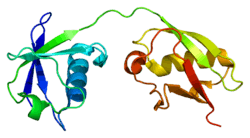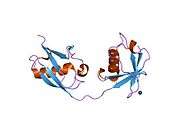ISG15
| View/Edit Human | View/Edit Mouse |
Interferon-stimulated gene 15 (ISG15) is a 17 kDA secreted protein that in humans is encoded by the ISG15 gene.[3][4] The main cellular function of the protein is ISGylation, its covalent addition to cytoplasmic and nuclear proteins, similar to ubiquitination. In addition, ISG15 has anti-viral activity.[5]
ISG15 shares several common properties with other ubiquitin-like molecules (UBLs), but its activity is tightly regulated by specific signaling pathways that have a role in innate immunity. ISG15 was identified as an interferon stimulated gene (ISG) since its expression is induced in response to type I interferons or lipopolysaccharide treatment. Upon interferon treatment, ISG15 can be detected in both free and conjugated forms, and is secreted from monocytes and lymphocytes where it can function as a cytokine. In the cell, ISG15 co-localizes with intermediate filaments and ISGylation may modulate the JAK-STAT pathway or certain aspects of neurological disease. It is also known as UCRP (ubiquitin cross-reactive protein) since it contains 2 tandem ubiquitin homology domains and is cross-reactive with ubiquitin antibodies. In contrast to other UBLs, ISG15 has not been identified in lower eukaryotes (yeast, nematode, insects, plants) indicating its role in specialized functions.
ISGylation
The mechanism of ISGylation and deISGylation is similar to that of ubiquitin, although the complete system components have not yet been identified. The activating E1 enzyme (UBE1L) charges ISG15 by forming a high-energy thiolester intermediate and transfers it to the UbcH8 E2 protein. UbcH8 has been identified as the major E2 for ISGylation, although it also functions in ubiquitination. The E2 protein subsequently transfers the ISG15 to specific E3 ligases (Herc5[6]) and relevant intracellular substrates. Only one deconjugating protease with specificity to ISG15 has been identified to date: UBP43 (a member of the USP family) cleaves ISG15-peptide fusions and also removes ISG15 (deISGylation) from native conjugates.[7]
Pathology
In pancreatic ductal adenocarcinoma, tumor-associated macrophages secrete ISG15 enhancing the phenotype of cancer stem cells in the tumor.[8]
References
- ↑ "Human PubMed Reference:".
- ↑ "Mouse PubMed Reference:".
- ↑ Blomstrom DC, Fahey D, Kutny R, Korant BD, Knight E Jr (Aug 1986). "Molecular characterization of the interferon-induced 15-kDa protein. Molecular cloning and nucleotide and amino acid sequence". J Biol Chem. 261 (19): 8811–6. PMID 3087979.
- ↑ "Entrez Gene: ISG15 ISG15 ubiquitin-like modifier".
- ↑ Morales, David J.; Lenschow, Deborah J. (December 2013). "The Antiviral Activities of ISG15". Journal of Molecular Biology. 425 (24): 4995–5008. doi:10.1016/j.jmb.2013.09.041.
- ↑ Woods, Matthew W. (et al) (17 November 2011). "Human HERC5 restricts an early stage of HIV-1 assembly by a mechanism correlating with the ISGylation of Gag". retrovirology.com. doi:10.1186/1742-4690-8-95. Retrieved 5 September 2011.
- ↑ "Boston Biochem ISG15 Overview". Archived from the original on 2008-05-02. Retrieved 2008-05-21.
- ↑ Sainz, B.; Martin, B.; Tatari, M.; Heeschen, C.; Guerra, S. (3 November 2014). "ISG15 Is a Critical Microenvironmental Factor for Pancreatic Cancer Stem Cells". Cancer Research. 74 (24): 7309–7320. doi:10.1158/0008-5472.CAN-14-1354.
Further reading
- Dastur A, Beaudenon S, Kelley M, Krug RM, Huibregtse JM (February 2006). "Herc5, an interferon-induced HECT E3 enzyme, is required for conjugation of ISG15 in human cells". J. Biol. Chem. 281 (7): 4334–8. doi:10.1074/jbc.M512830200. PMID 16407192.
- Bektas N, Noetzel E, Veeck J, et al. (2008). "The ubiquitin-like molecule interferon-stimulated gene 15 (ISG15) is a potential prognostic marker in human breast cancer". Breast Cancer Res. 10 (4): R58. doi:10.1186/bcr2117. PMC 2575531
 . PMID 18627608.
. PMID 18627608.
- Andersen JB, Hassel BA (2007). "The interferon regulated ubiquitin-like protein, ISG15, in tumorigenesis: friend or foe?". Cytokine Growth Factor Rev. 17 (6): 411–21. doi:10.1016/j.cytogfr.2006.10.001. PMID 17097911.
- Loeb KR, Haas AL (1992). "The interferon-inducible 15-kDa ubiquitin homolog conjugates to intracellular proteins". J. Biol. Chem. 267 (11): 7806–13. PMID 1373138.
- Clauss IM, Wathelet MG, Szpirer J, et al. (1990). "Chromosomal localization of two human genes inducible by interferons, double-stranded RNA, and viruses". Cytogenet. Cell Genet. 53 (2–3): 166–8. doi:10.1159/000132920. PMID 1695131.
- Knight E, Cordova B (1991). "IFN-induced 15-kDa protein is released from human lymphocytes and monocytes". J. Immunol. 146 (7): 2280–4. PMID 2005397.
- Haas AL, Ahrens P, Bright PM, Ankel H (1987). "Interferon induces a 15-kilodalton protein exhibiting marked homology to ubiquitin". J. Biol. Chem. 262 (23): 11315–23. PMID 2440890.
- Feltham N, Hillman M, Cordova B, et al. (1989). "A 15-kD interferon-induced protein and its 17-kD precursor: expression in Escherichia coli, purification, and characterization". J. Interferon Res. 9 (5): 493–507. doi:10.1089/jir.1989.9.493. PMID 2477469.
- Knight E, Fahey D, Cordova B, et al. (1988). "A 15-kDa interferon-induced protein is derived by COOH-terminal processing of a 17-kDa precursor". J. Biol. Chem. 263 (10): 4520–2. PMID 3350799.
- Reich N, Evans B, Levy D, et al. (1987). "Interferon-induced transcription of a gene encoding a 15-kDa protein depends on an upstream enhancer element". Proc. Natl. Acad. Sci. U.S.A. 84 (18): 6394–8. doi:10.1073/pnas.84.18.6394. PMC 299082
 . PMID 3476954.
. PMID 3476954. - Lowe J, McDermott H, Loeb K, et al. (1996). "Immunohistochemical localization of ubiquitin cross-reactive protein in human tissues". J. Pathol. 177 (2): 163–9. doi:10.1002/path.1711770210. PMID 7490683.
- Loeb KR, Haas AL (1994). "Conjugates of ubiquitin cross-reactive protein distribute in a cytoskeletal pattern". Mol. Cell. Biol. 14 (12): 8408–19. PMC 359380
 . PMID 7526157.
. PMID 7526157. - Narasimhan J, Potter JL, Haas AL (1996). "Conjugation of the 15-kDa interferon-induced ubiquitin homolog is distinct from that of ubiquitin". J. Biol. Chem. 271 (1): 324–30. doi:10.1074/jbc.271.1.324. PMID 8550581.
- D'Cunha J, Ramanujam S, Wagner RJ, et al. (1996). "In vitro and in vivo secretion of human ISG15, an IFN-induced immunomodulatory cytokine". J. Immunol. 157 (9): 4100–8. PMID 8892645.
- Smith JK, Siddiqui AA, Krishnaswamy GA, et al. (1999). "Oral use of interferon-alpha stimulates ISG-15 transcription and production by human buccal epithelial cells". J. Interferon Cytokine Res. 19 (8): 923–8. doi:10.1089/107999099313460. PMID 10476939.
- Bebington C, Doherty FJ, Fleming SD (1999). "Ubiquitin cross-reactive protein gene expression is increased in decidualized endometrial stromal cells at the initiation of pregnancy". Mol. Hum. Reprod. 5 (10): 966–72. doi:10.1093/molehr/5.10.966. PMID 10508226.
- Nyman TA, Matikainen S, Sareneva T, et al. (2000). "Proteome analysis reveals ubiquitin-conjugating enzymes to be a new family of interferon-alpha-regulated genes". Eur. J. Biochem. 267 (13): 4011–9. doi:10.1046/j.1432-1327.2000.01433.x. PMID 10866800.
- Yuan W, Krug RM (2001). "Influenza B virus NS1 protein inhibits conjugation of the interferon (IFN)-induced ubiquitin-like ISG15 protein". EMBO J. 20 (3): 362–71. doi:10.1093/emboj/20.3.362. PMC 133459
 . PMID 11157743.
. PMID 11157743. - Malakhov MP, Malakhova OA, Kim KI, et al. (2002). "UBP43 (USP18) specifically removes ISG15 from conjugated proteins". J. Biol. Chem. 277 (12): 9976–81. doi:10.1074/jbc.M109078200. PMID 11788588.
- Meraro D, Gleit-Kielmanowicz M, Hauser H, Levi BZ (2002). "IFN-stimulated gene 15 is synergistically activated through interactions between the myelocyte/lymphocyte-specific transcription factors, PU.1, IFN regulatory factor-8/IFN consensus sequence binding protein, and IFN regulatory factor-4: characterization of a new subtype of IFN-stimulated response element". J. Immunol. 168 (12): 6224–31. doi:10.4049/jimmunol.168.12.6224. PMID 12055236.
- Padovan E, Terracciano L, Certa U, et al. (2002). "Interferon stimulated gene 15 constitutively produced by melanoma cells induces e-cadherin expression on human dendritic cells". Cancer Res. 62 (12): 3453–8. PMID 12067988.



